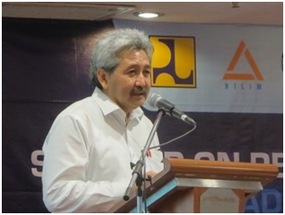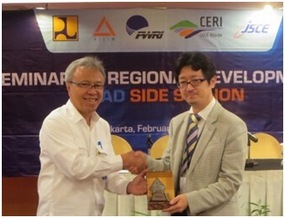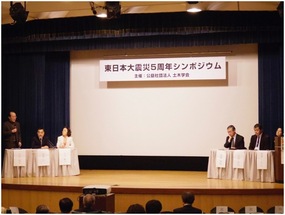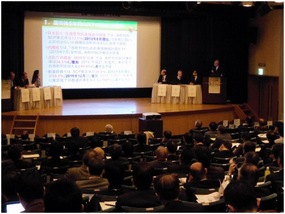IAC News
IAC News No.44, June 2016
Japan Society of Civil Engineers International Activities Center June 1, 2016 IAC News No.44
Report on an Open Seminar on Regional Development
The International Activities Center of the Japan Society of Civil Engineers held an Open Seminar on Regional Development in Jakarta, Indonesia on February 29, 2016, together with the Institute of Road Engineering, Ministry of Public Works (MPW) of Indonesia, the National Institute for Land and Infrastructure Management (NILIM), Ministry of Land, Infrastructure, Transport and Tourism (MLIT) and the Public Works Research Institute (PWRI). The seminar was very lively, attended by about 120 people from the Ministry of Public Works and the Ministry of Culture and Tourism of Indonesia, local governments and academic circles.
Seminar outline:
[Open Seminar on Regional Development]
Opening speech: Dr. Ir. Arie Setiadi Moerwanto, Director General of the Agency for Research and Development, MPW
Keynote speech: Dr. Hermanto Dardak, Head of Infrastructure Regional Board, MPW
Special lecture: “Roles of Traffic System Services in Regional Tourism Development” Prof. Tetsuo Shimizu, Tokyo Metropolitan University
Presentation: “Outline of ‘Michi-no-eki’ (Roadside Service Stations) and Recommendations for Better Operation” Dr. Masahide Ito, Director of Road Traffic Department, NILIM, MLIT
In addition to the above, Indonesian representatives gave four presentations.
Summary of the main presentation and lecture:
1. Keynote speech by Dr. Hermanto Dardak
Dr. Dardak talked about the challenge of reducing the economic gap between urban and rural areas in Indonesia, and described MPW projects in the strategic development regions. He also introduced the Smart Traveler’s Plaza Plan, a new project in Indonesia using the michi-no-eki in Japan for reference.
2. Special lecture by Prof. Tetsuo Shimizu
While showing the analysis results on the relationship between the history of tourism policies in Japan and the construction of roads and other infrastructure, the professor made proposals for tourism development in Indonesia that include (1) Indonesia’s domestic demand for tourism needing to be raised, (2) Traffic infrastructure that allows easy access to tourist spots needing to be built, and (3) Drive tourism should be promoted through measures such as constructing michi-no-eki.
[Reporter’s comment]
The Indonesian central and local governments have great expectations for regional development through constructing Smart Traveler’s Plazas which use Japan’s michi-no-eki as a reference. We need to continue exchange between engineers of both countries.

Dr. Hermanto delivers a speech.

Dr. Arie presents a tribute to Prof. Shimizu after his special lecture.
【Reported by Shigeo Murata, Indonesia Group, Int’l Cooperation Group, IAC】
2nd MES-JSCE Joint Symposium
The economy in Myanmar has gradually activated with the progress of democratization. In Yangon, which is the largest city of Myanmar, traffic demand has been increased radically, and current strong road infrastructure construction efforts are still insufficient. These conditions have contributed to more traffic congestion year by year. Although higher education institutions such as university started training of civil engineering engineers and researchers, they still face big challenges in terms of their quantity and quality. JSCE is asked to contribute to the development of solutions for the above challenge with JSCE’s member’s various knowledge and rich experiences gained through overseas technical cooperation and human resource development cooperation.
Based on the motivation above, the 2nd Joint Symposium was held with JSCE and the local counterpart, Myanmar Engineering Society (MES) on 21 to 22 March. 8 JSCE professionals including Mr. Asao Yamakawa, Acting Senior Director of IAC, Dr. Yukihiro Tukada, Executive Director of JSCE and Prof. Hiromichi Shirato of Kyoto University participated in the symposium. Mr. Shoichi Watanabe, First Secretary of Embassy of Japan in Myanmar, Mr. Tetsushi Hayakawa from JICA Myanmar office and Japanese company members also joined the symposium. Around 200 MES members including U Win Khaing, President of MES and Dr. Han Zaw, a past President of MES, who was awarded at JSCE International Award, participated in the symposium.
In the morning of the first day of the symposium, the General Session “Civil Engineering Education for Students & Professionals in Myanmar” and “Japan’s International Cooperation in the Civil Engineering Field” were held. In the afternoon, researches and projects regarding to bridge, river construction management, road & transportation were presented in Parallel Sessions. Each session had lively discussions, and then we shared the discussions held in every ssession in the final closing session. On the second day of the symposium, we visited Thilawa Special Economic Zone, New Thaketa Bridge and Yangon Circular Railway with JICA’s cooperation. Our biggest achievement through this program was that we could take the first step toward strengthening good network between engineers and researchers in Myanmar and Japan.
In the new government which was established on this March, U Win Khaing, President of MES, was inaugurated as Minister of Construction, and Dr. Kyaw Linn, Under Secretary of Ministry of Construction who was also awarded at JSCE International Award will continue his post. JSCE is going to plan to hold exchange program with MES actively by making use of such a lucky opportunity. We would appreciate if you could support and cooperate our activities.
Executive Members of MES and JSCE
Discussion between the JSCE delegates and MES President U Win Khaing and Dr. Han Zaw
【Reported by Tetsuo Shimizu, Myanmar Group Leader, Int’l Cooperation & Collaboration Group, IAC】
Report of Symposium of 5th Anniversary of Great East Japan Earthquake
The JSCE hosted a symposium on the 5th anniversary of the Great East Japan Earthquake at Hatsumeikaikan in Tokyo on March 1 and 2, 2016. The fifth event to commemorate the earthquake, the symposium was held under the theme of “The Past 5 Years - Preparing for Further Reconstruction and the Future.” Panel discussions examined six subjects (Table 1) that require collaboration between academia and society. Panelists from various fields, including planning science, sociology, agriculture, and civil engineering, actively engaged in discussions on a diverse range of topics.
The 300-seat hall was filled on both days. The audience intently listened to the discussions, asked questions, and gave comments and opinions. In Session 5, one participant asked, “Is agriculture not going to shift to next-generation agriculture during the reconstruction?” Another participant suggested that “future forecasting should cover at least next 100 years rather than a shorter period so that we could prepare for several predicted scenarios.” In Session 6, participants asked, “How can regions collaborate with one another?” and “Is consensus-building really necessary?” One participant commented, “In parallel with reconstruction in the regions, it should be urgent to work out measures for the problem of Japan’s low birth rate and aging population that has become more apparent and progressed rapidly since the disaster.” Five years after the earthquake and tsunami, discussions remain spirited, and the audience showed keen interest in the issues of “How should reconstruction be carried out in the future” and “How should the lessons learned from the disaster be applied to the next disaster.”
In the closing session, the head of each session summarized its discussions. To conclude the two-day symposium, the JSCE President Noriaki Hirose shared his views that the symposium showed the need for interdisciplinary standing committees on disaster reduction, disaster management, and reconstruction. Also he stated that he wanted to help society prepare for future disasters and subsequent reconstruction by collaborating with other academics societies.

One of the sessions at the 5th symposium

Participants listen to presentations.
| Session 1: | Disaster prevention and mitigation assessment: Comprehensive tsunami disaster prevention and mitigation |
| Session 2: | Seismic design system for “risk resistance” / Issues in planning, testing, and implementation |
| Session 3: | Implementation of measures to manage the radioactive waste from the Fukushima Daiichi nuclear power plant accident—Aimed at early reconstruction of Fukushima |
| Session 4: | Software in response to disaster—people, organizations, and regions |
| Session 5: | What we should learn from the experience of reconstruction in tsunami-affected areas in Tohoku |
| Session 6: | How should reconstruction proceed in the areas affected by the Fukushima Daiichi nuclear power plant accident? |
| Closing session: | Utilizing the experiences of the past 5 years for reconstruction and preparations for future disasters. |
【Reported by Ryosuke Takahashi, Leader of Information Group, IAC】
Updates
- The summary of feature articles in the JSCE Magazine is available on the JSCE website.
http://www.jsce-int.org/pub/magazine - Concrete Committee International Newsletter No. 45
http://www.jsce.or.jp/committee/concrete/e/newsletter/Newsletter.htm - Journal of JSCE
The Journal of JSCE is the collection of research papers which can be viewed on the JSCE website.
https://www.jstage.jst.go.jp/browse/journalofjsce - Disaster Fact Sheet
http://committees.jsce.or.jp/disaster/ - IAC Students and Alumni Network
http://www.jsce-int.org/IAC_network
IAC News Subscription
The IAC News is one of the communication tools to share information and ideas with the members. We would like to invite you, your friends and colleagues to join the communication and to subscribe the IAC News. Please register online: (http://www.jsce-int.org/node/150). We look forward to meeting you.
